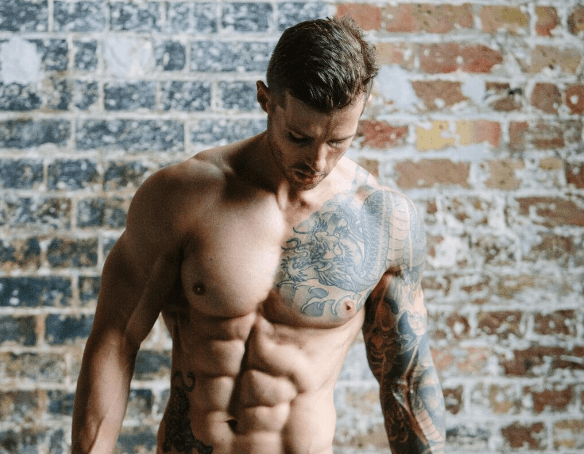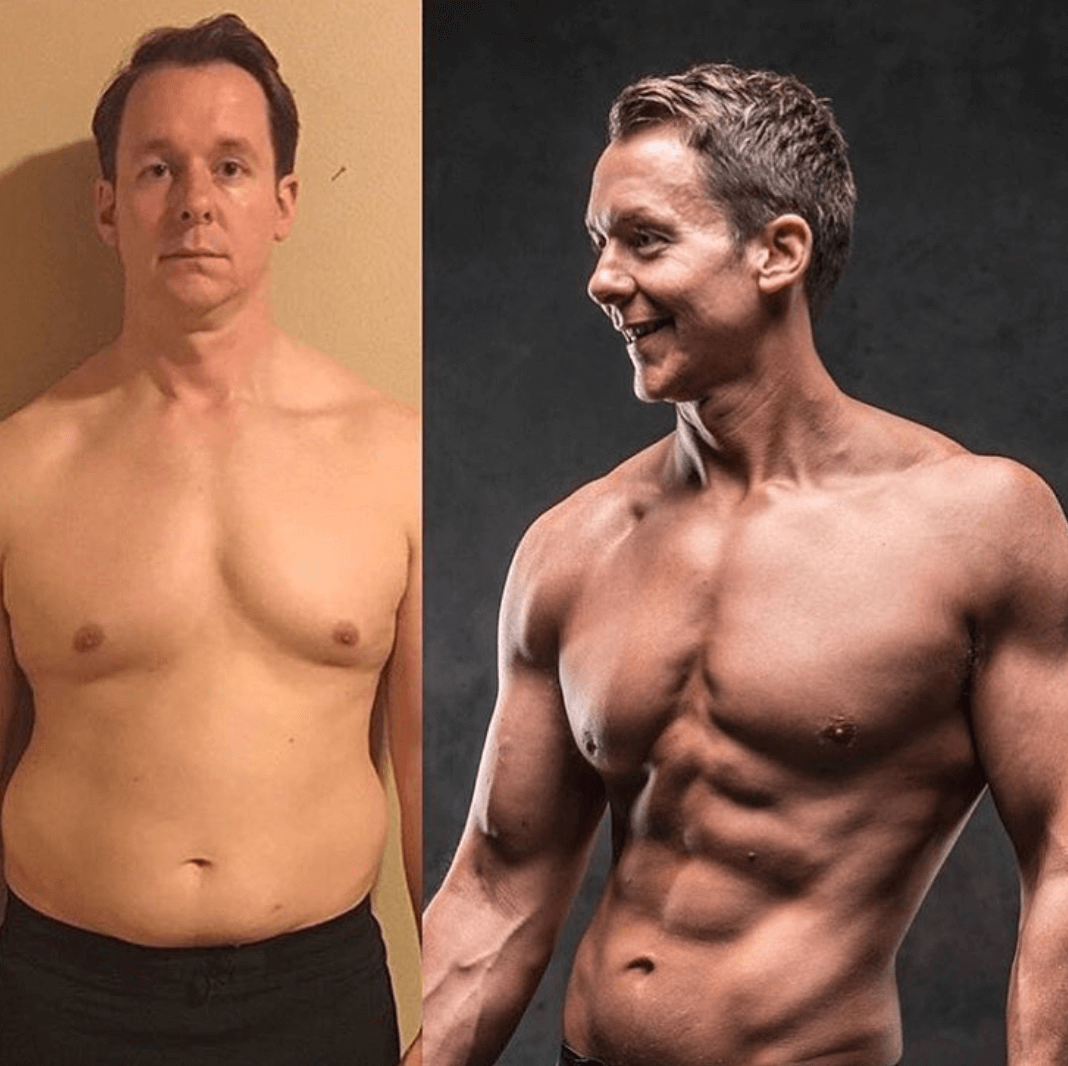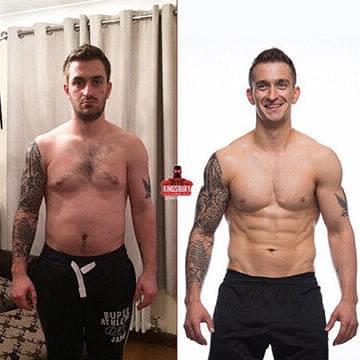What do you think is realistic for someone training clean?
Please let me know your thoughts below….
I’m going to be honest with you here my body fat levels vary throughout the year, I don’t always sit at 10% or less but I’ll let you into a secret. That’s totally normal!!
I train people through various phases to deliver the best results. Common phases I use are strength, hypertrophy and fat loss.
In these phases your body will change primarily in a positive way, with a solid plan and custom nutrition you can keep the results very postive keeping the negative changes that happen as a byproduct reduced.
During a hypertrophy phase may see some slight fat gains due to the calorie surplus. When I talk about a hypertrophy phases I’m not just talking training and rep ranges, although they do play a part, I am actually talking about your nutrition mainly.
You will know when I am in this phase as on my Instagram you will see me training double wrapped in hoodies. And if I am posting shirtless snaps they are old!
During a lean out phase some muscle loss may occur. So one of the main aims of this phase is to try and hang onto it. It’s worth still noting that the primary goal is fat loss so a little muscle may be sacrificed. But you will look much better for it!!
For the majority of people these phases of training are the only way of achieving low body fat whilst maintaining solid levels of muscle.
If you are training for physique goals then this phase approach is undoubtably the best option.
So you might ask…
How do I know what phase to be on?
Where to start?
Firstly – the easies way of looking like you have gained 10lb of muscle is by losing 10lb of fat.
So if you aren’t sure if you should lose fat first or build muscle first I would say it’s time to get lean!
Any muscle you build from a lean state will look much better than muscle built in a state of higher body fat levels.
Let have a look how I would set your goals based on your current levels
Being lean is the priority in my book.
I may bit a bit biased as my job is getting actors ready for film roles, and the camera isn’t flattering when you have layers of fat .
Hugh Jackman himself refers to me as “the best trainer he has have ever worked with” and I’m immensely proud of that statement. Part of the reason for him to make that comment is the level of body fat we were able to achieve on 3 films in a 2 year period (Les Mis, Wolverine and X-Men) each film pushing the limits further for both muscle gain and leanness.
Of all the questions I get asked a fitness trainer, the most popular one is “Can I build muscle and lose fat at the same time?” It seems like a fairly straight-forward question. The answer is pretty simple too and is – not really. When I get asked this though my instant reaction is why even consider trying to focus on both at the same time and achieve relatively little or nothing, when you can phase them for far superior results.
Most people want it all at once, but fitness is a journey. If you want to last the long road to serious results, then you have to enjoy and embrace the process (not just the results). The process being; various training phases and cycles to yield the best possible results over months and years not hours and days.
The traditional thinking tends to go either one route or the other and uses very simplistic logic to imply that:
Building Muscle = Calorie surplus, i.e. eat more calories than you burn.
Losing Body Fat = Calories deficit, i.e. eat fewer calories than you burn.
Don’t get me wrong, I agree with this 100% and think these should be two distinctive phases of training. However, within these two phases you may well see some very slight body recompositioning. This means that during the phase of adding lean muscle, you may see some very slight reductions in body fat for a short period of time. Alternatively, during a lean out plan, you may see very slight increases in your muscle mass for a short period of time.
THE FACT IS YOU WILL GET BETTER RESULTS OVERALL IF YOU FOCUS ON ONE AREA AT A TIME.
Leading on from that, if you are a beginner and you’re focusing on building muscle, even in a calorie surplus, follow these rules and make sure you are gaining strictly good weight.
- Carb and calorie cycling.
- Eat more carbs and calories on training days and less on non-weight training days.
- Eat healthy, whole foods.
- Train with intensity.
- Reduced rest periods, supersets, circuits etc
- Make the big lifts your foundation; squats, deadlifts, bench presses, chin-ups, dips, etc.
- Keep moving.
- Add some low intensity e.g. walking.
With a fat loss plan if you use the same principles, but in a calorie deficit you will drop body fat effectively and hold onto as much of that hard earned muscle as humanly possible.
SO What Should YOU Do First?
Where do you stand in the chart?

Really where you need to start depends on where you are at and where you want to go. You can see from this chart there are several levels of body fat. The truth about measuring body fat is the accuracy of the measurement. It comes down to the quality of the test and the person testing.
A skin fold test with an experienced user will bring accurate results, but with a novice will be useless. So a simple and effective measuring process is an image comparison. Print the chart above and an image of yourself for comparison.
It’s always a good idea to get a second opinion on this too. Often people are hard on themselves (more often still, too easy on themselves!), so having someone else to offer an impartial opinion as you work towards your goal can be a great incentive and more likely to get a more accurate initial result which you can build on.
My Guidelines for Adding Muscle
I’ll let you into a little secret. I once started a never-ending bulk. Well, I say ‘never-ending’, whilst it didn’t run for an eternity, it did last the best part of two years. The end result wasn’t what I expected at all. I looked worse at 105kg than I ever did at 90kg. After all the blood, sweat, tears and hours in the gym, all my hard work meant I was disappointed. Not in my effort, but in the results.
If you’re considering bulking up, my suggestion would be to never go above 15-20% when adding lean muscle. This might mean integrating some shorter ‘lean out’ phases along the way to ensure you continue to progress in the right direction, without too much body fat creeping on.
The reason I suggest not going higher than 15-20% is two-fold,
- Capacity
- Once a fat cell reaches its maximum capacity, your body produces a new fat cell to store additional fat.
2. Permanence
- When you lose fat you essentially empty your fat cell, but the total number of cells only decreases slightly (if at all). The cells do, however, become less metabolically active and they remain in your body, waiting quietly and patiently until you fall off the wagon, mouth-first onto a wagon wheel. Because the number of them doesn’t reduce, the body will store fat more easily the second time round. It can be a vicious circle that can be harder to escape from so it’s best to be aware of it from the start.
My Guidelines for Getting Lean
For most people, being at or around 10% is the goal; to hold a body fat that looks awesome and, more importantly, that can be maintained (or keep it close to maintenance). For most people this will be done in two phases; a lean build followed by a trim down, then once the desired body fat is achieved there are several ways to keeping close to it through maintenance or smaller training cycles of lean build and lean out training blocks.
If you have a lot of mass already, then you can skip the lean build and just cut down. Training through phases will bring better results than trying to do it all and hit a number of goals at once. The key is training with specificity and focusing on one goal at a time.
Either work in an overall calorie deficit of calories and focus on fat loss with carbs and calories cycled to favour your weight training days. Alternatively, work in a calorie surplus with adding muscle as your primary goal.
The phase length will vary depending on your starting position, goals, response to training, training history and how strictly you follow the plan.
Typically, I work in training phases of 8-12 weeks of each target. This means working for this length of time specifically on one goal. These will vary from person to person and for making those decisions I strongly suggest a custom plan. If you need help with that, just let me know.
Do I need to train in phases?
If you want the best results, then the phase approach offers the most effective route. This applies to all training for all goals. Training phases don’t have to be related to bodyweight or body fat levels. Speed athletes will work through strength and speed phases. Endurance athletes will work through various phases with emphasizes in different zones to give a couple of examples.










